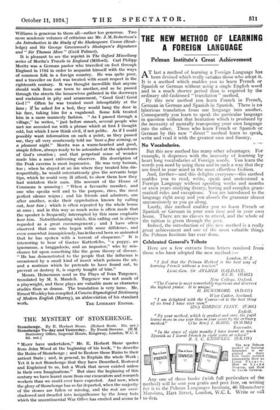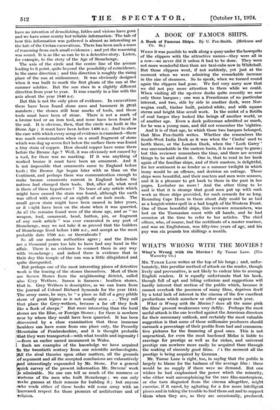THE MYSTERY OF STONEHENGE.
Stationery Office, Imperial House, Kingsway, London, W.C. 2. 6d. net.) " MANy have undertaken," Mr. E. Herbert Stone quotes from John Wood at the beginning of his book, "to describe the Ruins of Stonehenge ; and to Restore those Ruins to their antient State ; and, in general, to Explain the whole Work ; Yet it is not Stonehenge that they have Described, Restored and Explained to us, but a Work that never existed unless in their own Imaginations." But since the beginning of this century we have learnt more from our excavators and research workers than we could ever have expected. And now, when the glory of Stonehenge has so far departed, when the majority
of the stones are fallen or missing, and the rest. are over- shadowed and dwarfed into insignificance by the Army huts
which the unsentimental War Office has erected and seems to
have no intention of demolishing, fables and visions have gone and we have some scanty but-reliable information; The tale of how this information was gathered is almost as interesting as the tale of the Cretan excavations. There has been such a mass of reasoning from such small evidences ; and yet the reasoning was sound. It is as like as can be to a detective story. Listen, for example, to the story of the Age of Stonehenge.
The axis of the circle and the centre line of the avenue leading to it point, quite beyond the possibility of coincidence, In the same direction ; and this direction is roughly the rising place of the sun at midsummer. It was obviously designed when it was built to .mark the first gleam of the sun at the summer solstice. But the sun rises in a slightly different direction from year to year. It rose exactly in a line with the axis about the year 1840 B.C.
But this is not the only piece of evidence. In excavations there have been found stone axes and hammers in great numbers ; the stones still bear marks of tools, and those tools must have been of stone. There is not a mark of a bronze tool or an iron tool, and none have been found in the soil. It is obvious, then, that the circle was built in the Stone Age ; it must have been before 1400 B.C. And to show the care with which every scrap of evidence is examined—there was much consternation when on a small fragment of stone which was dug up seven feet below the surface there was found a tiny stain of copper. How should copper have come there before the Bronze Age Well, it was obviously not caused by a tool, for there was no marking. If it was anything of worked bronze it must have been an ornament. And it is not impossible that ornaments came to England before tools ; the Bronze Age began later with us than on the Continent, and perhaps there was communication enough to make bronze ornaments current in England before the natives had changed their tools. But, after all, what need is there of these hypotheses ? No trace of any article which might have caused the stain was found, although the earth was sifted with sieves of an eighth of an inch mesh. The small green stain might have been caused in later years, or it might have been on the stone when it was quarried. As a..i the remains found were of the stone age, and as "no weapon, tool, ornament, bead, button, pin, or fragment of any such article" was ever excavated in any part of Stonehenge, may we not take it as proved that the builders of Stonehenge lived before 1400 n.c., and accept as the most probable date 1700 B.c. or thereabouts ?
So all our modern authorities agree ; and the Druids are a thousand years too late to have had any hand in the affair. There is no evidence to connect them in any way with Stonehenge ; and indeed there is evidence that in their day this temple of the sun was a little dilapidated and quite disregarded.
But perhaps one of the most interesting pieces of detective work is the tracing of the stones themselves. Most of them are Sarsen Stones from the neighbouring district, called also Grey Wethers. Sarsen is Saracen : heathen stones, that is. Grey Wethers is descriptive, as we can learn from the journal of Colonel Richard Symonds for the year 1644. The army came, he says, to "a place so full of a grey pibble stone of great bignes as is not usually seen. . . They call that place the Grey-wethers, because a far off they look like a flock of sheepe." But more interesting than the local stones are the Blue, or Foreign Stones ; for there is nowhere near by where they could have been quarried. It has been 'discovered by a close examination that these immense !boulders can have come from one place only, the Prescelly PMountains of Pembrokeshire, and it is thought probable Ithat they were transported—with what trouble and ingenuity 1—from an earlier sacred monument in Wales.
Such are examples of the knowledge we have acquired In the twentieth century from our scientific archaeologists. rAll the rival theories upon other matters, all the grounds of argument and all the accepted conclusions are exhaustively 1and interestingly expounded by Mr. Stone. For a general quick survey of the present information Mr. Stevens' work is admirable. No one can tell us much of the manners or !customs of the men who built Stonehenge ; we can only :nuke guesses at their reasons for building it ; but anyone, mho reads either of these books will come away with an !increased respect for those pioneers of architecture and of religion.











































 Previous page
Previous page